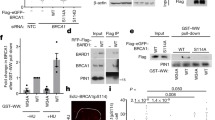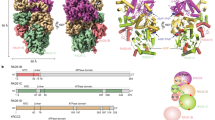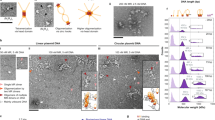Abstract
The Rad50 ABC–ATPase complex with Mre11 nuclease is essential for dsDNA break repair, telomere maintenance and ataxia telangiectasia–mutated kinase checkpoint signaling. How Rad50 affects Mre11 functions and how ABC–ATPases communicate nucleotide binding and ligand states across long distances and among protein partners are questions that have remained obscure. Here, structures of Mre11–Rad50 complexes define the Mre11 2-helix Rad50 binding domain (RBD) that forms a four-helix interface with Rad50 coiled coils adjoining the ATPase core. Newly identified effector and basic-switch helix motifs extend the ABC–ATPase signature motif to link ATP-driven Rad50 movements to coiled coils binding Mre11, implying an ~30-Å pull on the linker to the nuclease domain. Both RBD and basic-switch mutations cause clastogen sensitivity. Our new results characterize flexible ATP-dependent Mre11 regulation, defects in cancer-linked RBD mutations, conserved superfamily basic switches and motifs effecting ATP-driven conformational change, and they provide a unified comprehension of ABC–ATPase activities.
This is a preview of subscription content, access via your institution
Access options
Subscribe to this journal
Receive 12 print issues and online access
$189.00 per year
only $15.75 per issue
Buy this article
- Purchase on Springer Link
- Instant access to full article PDF
Prices may be subject to local taxes which are calculated during checkout







Similar content being viewed by others
Change history
21 September 2011
In the version of this article initially published, panels in Figures 2b (middle row, Dex-LWH), 3b (0.1μM CPT) and 3d (0.1μM CPT) were mistakenly replaced with duplicates of adjacent panels. The errors have been corrected in the HTML and PDF versions of the article.
06 April 2011
In the version of this article initially published, the acronym ENIGMA was spelled out incorrectly in the Acknowledgments section. The error has been corrected in the HTML and PDF versions of the article.
References
Paull, T.T. & Gellert, M. Nbs1 potentiates ATP-driven DNA unwinding and endonuclease cleavage by the Mre11/Rad50 complex. Genes Dev. 13, 1276–1288 (1999).
Trujillo, K.M. & Sung, P. DNA structure-specific nuclease activities in the Saccharomyces cerevisiae Rad50-Mre11 complex. J. Biol. Chem. 276, 35458–35464 (2001).
Williams, G.J., Lees-Miller, S.P. & Tainer, J.A. Mre11-Rad50-Nbs1 conformations and the control of sensing, signaling, and effector responses at DNA double-strand breaks. DNA Repair (Amst.) 9, 1299–1306 (2010).
Williams, R.S., Williams, J.S. & Tainer, J.A. Mre11-Rad50-Nbs1 is a keystone complex connecting DNA repair machinery, double-strand break signaling, and the chromatin template. Biochem. Cell Biol. 85, 509–520 (2007).
Carney, J.P. et al. The hMre11/hRad50 protein complex and Nijmegen breakage syndrome: linkage of double-strand break repair to the cellular DNA damage response. Cell 93, 477–486 (1998).
Waltes, R. et al. Human RAD50 deficiency in a Nijmegen breakage syndrome-like disorder. Am. J. Hum. Genet. 84, 605–616 (2009).
Wang, Z. et al. Three classes of genes mutated in colorectal cancers with chromosomal instability. Cancer Res. 64, 2998–3001 (2004).
Hopkins, B.B. & Paull, T.T. The P. furiosus Mre11/Rad50 complex promotes 5′ strand resection at a DNA double-strand break. Cell 135, 250–260 (2008).
Williams, R.S. et al. Mre11 dimers coordinate DNA end bridging and nuclease processing in double-strand-break repair. Cell 135, 97–109 (2008).
Hopfner, K.P. et al. Structural biochemistry and interaction architecture of the DNA double-strand break repair Mre11 nuclease and Rad50-ATPase. Cell 105, 473–485 (2001).
Hopfner, K.P. et al. Structural biology of Rad50 ATPase: ATP-driven conformational control in DNA double-strand break repair and the ABC-ATPase superfamily. Cell 101, 789–800 (2000).
Hopfner, K.P. et al. The Rad50 zinc-hook is a structure joining Mre11 complexes in DNA recombination and repair. Nature 418, 562–566 (2002).
Williams, R.S. et al. Nbs1 flexibly tethers Ctp1 and Mre11-Rad50 to coordinate DNA double-strand break processing and repair. Cell 139, 87–99 (2009).
Borgstahl, G.E. et al. The structure of human mitochondrial manganese superoxide dismutase reveals a novel tetrameric interface of two 4-helix bundles. Cell 71, 107–118 (1992).
Craig, L. et al. Type IV pilin structure and assembly: X-ray and EM analyses of Vibrio cholerae toxin-coregulated pilus and Pseudomonas aeruginosa PAK pilin. Mol. Cell 11, 1139–1150 (2003).
Craig, L. et al. Type IV pilus structure by cryo-electron microscopy and crystallography: implications for pilus assembly and functions. Mol. Cell 23, 651–662 (2006).
Ward, J.J., Sodhi, J.S., McGuffin, L.J., Buxton, B.F. & Jones, D.T. Prediction and functional analysis of native disorder in proteins from the three kingdoms of life. J. Mol. Biol. 337, 635–645 (2004).
Limbo, O. et al. Ctp1 is a cell-cycle–regulated protein that functions with Mre11 complex to control double-strand break repair by homologous recombination. Mol. Cell 28, 134–146 (2007).
Tomita, K. et al. Competition between the Rad50 complex and the Ku heterodimer reveals a role for Exo1 in processing double-strand breaks but not telomeres. Mol. Cell. Biol. 23, 5186–5197 (2003).
Putnam, C.D., Hammel, M., Hura, G.L. & Tainer, J.A. X-ray solution scattering (SAXS) combined with crystallography and computation: defining accurate macromolecular structures, conformations and assemblies in solution. Q. Rev. Biophys. 40, 191–285 (2007).
Pelikan, M., Hura, G.L. & Hammel, M. Structure and flexibility within proteins as identified through small angle X-ray scattering. Gen. Physiol. Biophys. 28, 174–189 (2009).
Sokolova, A.V., Volkov, V.V. & Svergun, D.I. Prototype of a database for rapid protein classification based on solution scattering data. J. Appl. Crystallogr. 36, 865–868 (2003).
Moreno-Herrero, F. et al. Mesoscale conformational changes in the DNA-repair complex Rad50/Mre11/Nbs1 upon binding DNA. Nature 437, 440–443 (2005).
Usui, T., Petrini, J.H. & Morales, M. Rad50S alleles of the Mre11 complex: questions answered and questions raised. Exp. Cell Res. 312, 2694–2699 (2006).
Rees, D.C., Johnson, E. & Lewinson, O. ABC transporters: the power to change. Nat. Rev. Mol. Cell Biol. 10, 218–227 (2009).
Hopfner, K.P. & Tainer, J.A. Rad50/SMC proteins and ABC transporters: unifying concepts from high-resolution structures. Curr. Opin. Struct. Biol. 13, 249–255 (2003).
Bobadilla, J.L., Macek, M., Fine, J.P. & Farrell, P.M. Cystic fibrosis: a worldwide analysis of CFTR mutations–correlation with incidence data and application to screening. Hum. Mutat. 19, 575–606 (2002).
Lewis, H.A. et al. Structure of nucleotide-binding domain 1 of the cystic fibrosis transmembrane conductance regulator. EMBO J. 23, 282–293 (2004).
Oldham, M.L., Khare, D., Quiocho, F.A., Davidson, A.L. & Chen, J. Crystal structure of a catalytic intermediate of the maltose transporter. Nature 450, 515–521 (2007).
Dawson, R.J. & Locher, K.P. Structure of a bacterial multidrug ABC transporter. Nature 443, 180–185 (2006).
Pinkett, H.W., Lee, A.T., Lum, P., Locher, K.P. & Rees, D.C. An inward-facing conformation of a putative metal-chelate-type ABC transporter. Science 315, 373–377 (2007).
Vergani, P., Lockless, S.W., Nairn, A.C. & Gadsby, D.C. CFTR channel opening by ATP-driven tight dimerization of its nucleotide-binding domains. Nature 433, 876–880 (2005).
Szollosi, A., Vergani, P. & Csanády, L. Involvement of F1296 and N1303 of CFTR in induced-fit conformational change in response to ATP binding at NBD2. J. Gen. Physiol. 136, 407–423 (2010).
Garmory, H.S. & Titball, R.W. ATP-binding cassette transporters are targets for the development of antibacterial vaccines and therapies. Infect. Immun. 72, 6757–6763 (2004).
Lou, H. & Dean, M. Targeted therapy for cancer stem cells: the patched pathway and ABC transporters. Oncogene 26, 1357–1360 (2007).
Abuzeid, W.M. et al. Molecular disruption of RAD50 sensitizes human tumor cells to cisplatin-based chemotherapy. J. Clin. Invest. 119, 1974–1985 (2009).
Dupré, A. et al. A forward chemical genetic screen reveals an inhibitor of the Mre11-Rad50-Nbs1 complex. Nat. Chem. Biol. 4, 119–125 (2008).
Farmer, H. et al. Targeting the DNA repair defect in BRCA mutant cells as a therapeutic strategy. Nature 434, 917–921 (2005).
Zorn, J.A. & Wells, J.A. Turning enzymes ON with small molecules. Nat. Chem. Biol. 6, 179–188 (2010).
Kuhn, L.A. et al. The interdependence of protein surface topography and bound water molecules revealed by surface accessibility and fractal density measures. J. Mol. Biol. 228, 13–22 (1992).
Garcin, E.D. et al. Anchored plasticity opens doors for selective inhibitor design in nitric oxide synthase. Nat. Chem. Biol. 4, 700–707 (2008).
Otwinowski, Z. & Minor, W. Processing of X-ray diffraction data collected in oscillation mode. Meth. Enzymol. 276, 307–326 (1997).
Vagin, A. & Teplyakov, A. Molecular replacement with MOLREP. Acta Crystallogr. D66, 22–25 (2010).
Murshudov, G.N., Vagin, A.A. & Dodson, E.J. Refinement of macromolecular structures by the maximum-likelihood method. Acta Crystallogr. D53, 240–255 (1997).
Adams, P.D. et al. PHENIX: a comprehensive Python-based system for macromolecular structure solution. Acta Crystallogr. D66, 213–221 (2010).
Jones, T.A., Zou, J.Y., Cowan, S.W. & Kjeldgaard, M. Improved methods for building protein models in electron density maps and the location of errors in these models. Acta Crystallogr. A47 (Pt. 2), 110–119 (1991).
Emsley, P., Lohkamp, B., Scott, W.G. & Cowtan, K. Features and development of Coot. Acta Crystallogr. D66, 486–501 (2010).
Hura, G.L. et al. Robust, high-throughput solution structural analyses by small angle X-ray scattering (SAXS). Nat. Methods 6, 606–612 (2009).
Konarev, P.V., Volkov, V.V., Sokolova, A.V., Koch, M.H.J. & Svergun, D.I. PRIMUS: a Windows PC-based system for small-angle scattering data analysis. J. Appl. Crystallogr. 36, 1277–1282 (2003).
Schneidman-Duhovny, D., Hammel, M. & Sali, A. FoXS: a web server for rapid computation and fitting of SAXS profiles. Nucleic Acids Res. 38, W540–W544 (2010).
Moreno, S., Klar, A. & Nurse, P. Molecular genetic analysis of fission yeast Schizosaccharomyces pombe. Methods Enzymol. 194, 795–823 (1991).
Werler, P.J.H., Hartsuiker, E. & Carr, A.M. A simple Cre-loxP method for chromosomal N-terminal tagging of essential and non-essential Schizosaccharomyces pombe genes. Gene 304, 133–141 (2003).
Acknowledgements
This MRN research is supported by National Cancer Institute grants CA117638 (J.A.T. and P.R.), CA92584 (J.A.T.), CA77325 (P.R.) and in part by the US National Intitutes of Health Intramural Research program 1Z01ES102765-01 (R.S.W.). Microbial complex efforts are supported by the Ecosystems and Networks Integrated with Genes and Molecular Assemblies (ENIGMA) Program of the Department of Energy, Office of Biological and Environmental Research, through contract DE-AC02-05CH11231 with Lawrence Berkeley National Laboratory (J.A.T.). The Structurally Integrated Biology for Life Sciences (SIBYLS) beamline (BL12.3.1) at the Advanced Light Source is supported by United States Department of Energy program Integrated Diffraction Analysis Technologies DE-AC02-05CH11231 (J.A.T.). We thank G. Hura (Lawrence Berkeley National Laboratory) for expert SAXS data collection assistance.
Author information
Authors and Affiliations
Contributions
G.J.W. analyzed results, did SAXS experiments and wrote the manuscript. J.S.W. and O.L. did S. pombe experiments and analysis. G.M. and R.S.W. solved crystal structures. A.S.A. refined structures. S.S. and G.G. purified proteins. M.H. assisted with SAXS analyses. R.S.W., J.S.W., P.R. and J.A.T. designed research, analyzed results and helped write the manuscript.
Corresponding authors
Ethics declarations
Competing interests
The authors declare no competing financial interests.
Supplementary information
Supplementary Text and Figures
Supplementary Figures 1–6, Supplementary Table 1 and Supplementary Methods (PDF 8370 kb)
Supplementary Movie 1
Nucleotide-induced Rad50 conformational changes. Rad50 structures with coiled-coil regions in the absence (start position) and presence (end position) of nucleotide were superimposed and movies generated by morphing between states in PyMOL (DeLano Scientific LLC, Palo Alto, CA, U.S.A. http://www.pymol.org). Supplementary Movie 1 shows the N-lobe rotation with respect to the C-lobe. Supplementary Movie 2 shows the C-lobe rotation with respect to the N-lobe. Supplementary Movie 3 shows the C-lobe rotation with respect to the N-lobe from the side. The extended signature motif (magenta) and signature coupling helices (cyan) are highlighted. Residues in the text are shown as sticks with the extended signature motif basic-switch residues (Arg797 and Arg805) highlighted by representation of side chain nitrogens as spheres. To relate the movements to nucleotide binding AMP:PNP is shown as sticks, although it is only observed in the structure of the nucleotide bound form. To relate the movements to bound Mre11 RBD, residues on the Rad50 coiled-coils involves in the Mre11RBD–Rad50 interface are shown in a green transparent surface representation. For clarity only one Rad50 molecule is shown, although in structures in the presence of nucleotide dimerization occurs with AMP:PNP sandwiched between ABC-ATPase domains. (MOV 8250 kb)
Supplementary Movie 2
Nucleotide-induced Rad50 conformational changes. Rad50 structures with coiled-coil regions in the absence (start position) and presence (end position) of nucleotide were superimposed and movies generated by morphing between states in PyMOL (DeLano Scientific LLC, Palo Alto, CA, U.S.A. http://www.pymol.org). Supplementary Movie 1 shows the N-lobe rotation with respect to the C-lobe. Supplementary Movie 2 shows the C-lobe rotation with respect to the N-lobe. Supplementary Movie 3 shows the C-lobe rotation with respect to the N-lobe from the side. The extended signature motif (magenta) and signature coupling helices (cyan) are highlighted. Residues in the text are shown as sticks with the extended signature motif basic-switch residues (Arg797 and Arg805) highlighted by representation of side chain nitrogens as spheres. To relate the movements to nucleotide binding AMP:PNP is shown as sticks, although it is only observed in the structure of the nucleotide bound form. To relate the movements to bound Mre11 RBD, residues on the Rad50 coiled-coils involves in the Mre11RBD–Rad50 interface are shown in a green transparent surface representation. For clarity only one Rad50 molecule is shown, although in structures in the presence of nucleotide dimerization occurs with AMP:PNP sandwiched between ABC-ATPase domains (MOV 9395 kb)
Supplementary Movie 3
Nucleotide-induced Rad50 conformational changes. Rad50 structures with coiled-coil regions in the absence (start position) and presence (end position) of nucleotide were superimposed and movies generated by morphing between states in PyMOL (DeLano Scientific LLC, Palo Alto, CA, U.S.A. http://www.pymol.org). Supplementary Movie 1 shows the N-lobe rotation with respect to the C-lobe. Supplementary Movie 2 shows the C-lobe rotation with respect to the N-lobe. Supplementary Movie 3 shows the C-lobe rotation with respect to the N-lobe from the side. The extended signature motif (magenta) and signature coupling helices (cyan) are highlighted. Residues in the text are shown as sticks with the extended signature motif basic-switch residues (Arg797 and Arg805) highlighted by representation of side chain nitrogens as spheres. To relate the movements to nucleotide binding AMP:PNP is shown as sticks, although it is only observed in the structure of the nucleotide bound form. To relate the movements to bound Mre11 RBD, residues on the Rad50 coiled-coils involves in the Mre11RBD–Rad50 interface are shown in a green transparent surface representation. For clarity only one Rad50 molecule is shown, although in structures in the presence of nucleotide dimerization occurs with AMP:PNP sandwiched between ABC-ATPase domains (MOV 7497 kb)
Rights and permissions
About this article
Cite this article
Williams, G., Williams, R., Williams, J. et al. ABC ATPase signature helices in Rad50 link nucleotide state to Mre11 interface for DNA repair. Nat Struct Mol Biol 18, 423–431 (2011). https://doi.org/10.1038/nsmb.2038
Received:
Accepted:
Published:
Issue Date:
DOI: https://doi.org/10.1038/nsmb.2038
This article is cited by
-
The β2Tubulin, Rad50-ATPase and enolase cis-regulatory regions mediate male germline expression in Tribolium castaneum
Scientific Reports (2021)
-
The structure of the cohesin ATPase elucidates the mechanism of SMC–kleisin ring opening
Nature Structural & Molecular Biology (2020)
-
Rad50 zinc hook functions as a constitutive dimerization module interchangeable with SMC hinge
Nature Communications (2020)
-
Structural basis of homologous recombination
Cellular and Molecular Life Sciences (2020)
-
A dynamic allosteric pathway underlies Rad50 ABC ATPase function in DNA repair
Scientific Reports (2018)



